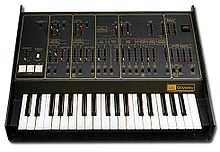ARP Odyssey
This article needs additional citations for verification. (April 2014) |
| Odyssey | |
|---|---|
 ARP Odyssey Mark III | |
| Manufacturer | ARP Instruments, Inc. Korg Inc. (from 2015) |
| Dates | 1972 - 1981 2015 - Present |
| Technical specifications | |
| Polyphony | 1-2 |
| Oscillator | 2 |
| LFO | Sine, Square, S&H |
| Synthesis type | Analog Subtractive |
| Attenuator | AR, ADSR |
| Storage memory | none |
| Effects | none |
| Input/output | |
| Keyboard | 37-key |
| Left-hand control | Pitch |
| External control | CV/Gate |
The ARP Odyssey is an analog synthesizer introduced in 1972. Responding to pressure from Moog Music to create a portable, affordable (the Minimoog was US$1,495 upon release) "performance" synthesizer, ARP scaled down its popular 2600 synthesizer and created the Odyssey, which became the best-selling synthesizer they made.
There were several variations of the Odyssey over the years. Following an announcement in February 2014, the synthesizer was reissued by Korg in early 2015, in cooperation with the synthesizer's original designer and ARP co-founder, David Friend.[1][2]
Design
This section needs expansion. You can help by adding to it. (November 2015) |
The Odyssey is a two-oscillator analog synthesizer, and one of the first with duophonic capabilities (the ability to play two notes at the same time). One potential appeal of the Odyssey is the fact that all parameters, including a resonant low-pass filter, a non-resonant high-pass filter, ADSR and AR envelopes, a triangle (not sine) and square wave LFO, and a sample-and-hold function are controllable with sliders and switches on the front panel.
Features
- Switchable between sawtooth, square, and pulse waveforms with oscillator sync, a ring modulator, and pink or white noise.
- Pulse-width can be modulated manually or with the LFO or the ADSR envelope generator. There is a (static) high-pass filter, as well as a voltage controlled low-pass self-oscillating filter.
- The filter can be controlled by either of the two envelope generators, an ADSR (attack, decay, sustain, release) and a simple AR (attack, release) and modulated by the LFO, sample-and-hold, the keyboard, or a separate CV (pedal) input on the back panel.
- The Sample/Hold input mixer can be used to route the output of the VCOs to the FM input of VCO 2 and the VCF, enabling audio frequency FM.
ARP Odyssey models
Odyssey Mk I (Model 2800)

ARP Odysseys produced between 1972 and 1975, referred to as Mark I, were white-faced Odysseys that used a 2-pole voltage-controlled filter, which were similar to Oberheim SEM modules. Some late models used a black and gold color scheme and include CV/gate jacks like the later Mark II's. These earlier units contained a greater number of internal adjustments and were slightly more difficult to calibrate.
Odyssey Mk II (Model 2810-5)

Odyssey Mark II's were produced between 1975 and 1978. They are largely similar to Mark I's; the main differences are the use of the black and gold color scheme and the inclusion of CV/gate in all models. These models also use a four-pole VCF, which were similar in design to Moog's four-pole filter. Subsequent models, however, use a different four-pole low-pass filter designed by ARP, the 4075 filter. A later filter with a similar design, the 4072, was used in the 2600, Omni, Axxe, Solus, and other ARP instruments.
Odyssey Mk III (Model 2820-2823)
Mark III was produced between 1978 and 1981, and was the last model until Korg's revival of the Odyssey in 2015. Mark III's are also the most common models of the Odyssey. The Mark III used ARP's four-pole 4075 filter and introduced proportional pitch control (PPC). PPC was a pitch bend system created by ARP that used pressure-sensitive buttons to control bend up, bend down, and vibrato. Older models had used a standard knob. Apart from the new filter and pitch bend, the distinguishing feature of the Mark III is its orange and black color scheme, which was consistent with other contemporary ARP instruments.
Mark III Odysseys also have unbalanced XLR outputs, in addition to unbalanced 1/4" outputs.
Korg ARP Odyssey

The ARP Odyssey was reissued by Korg in 2015 with modifications to make the instrument more modern. The Korg ARP Odyssey introduced MIDI in and USB MIDI, as well as a separate headphone output and balanced XLR output. It also adds a drive option to distort the voltage-controlled amplifier. Korg's models include features of all three of the original Odyssey models, including the ability to switch between their filters and portamento behaviors. The color scheme follows the Mark III, although Mark I and II styles were available in limited editions. On Nov 1, 2016 Korg announced the Arp Odyssei for iOS.
References
- ^ a b "Korg Announces the development of the ARP Odyssey synthesizer". Korg. Retrieved 17 February 2014.
- ^ "The resurrection of ARP by Korg". arpsynth.com. May 2014. Retrieved 4 November 2015.
